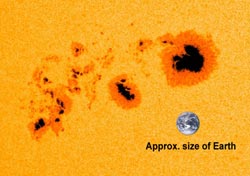NASA's SDO Sees Giant January Sunspots

One of the largest sunspots in the last nine years, labeled AR1944, was seen in early January 2014, as captured by NASA's Solar Dynamics Observatory. An image of Earth has been added for scale. Image Credit: NASA/SDO<br>
The sunspot steadily moved toward the right, along with the rotation of the sun, and now sits almost dead center, as seen in the image above from NASA's Solar Dynamics Observatory.
Sunspots are dark areas on the sun's surface that contain complex arrangements of strong magnetic fields that are constantly shifting. The largest dark spot in this configuration is approximately two Earths wide, and the entire sunspot group is some seven Earths across.
For comparison, another giant sunspot, five to six Earths across, is shown below from 2005. The image was captured by the European Space Agency and NASA's Solar and Heliospheric Observatory.
Sunspots are part of what's known as active regions, which also include regions of the sun's atmosphere, the corona, hovering above the sunspots. Active regions can be the source of some of the sun's great explosions: solar flares that send out giant bursts of light and radiation due to the release of magnetic energy, or coronal mass ejections that send huge clouds of solar material out into space.
As the sunspot group continues its journey across the face of the sun, scientists will watch how it changes and evolves to learn more about how these convoluted magnetic fields can cause space weather events that can affect space-borne systems and technological infrastructure on Earth.
For more information on sunspots and space weather, visit:
http://www.nasa.gov/mission_pages/sunearth/spaceweather/index.html
Karen C. Fox
NASA's Goddard Space Flight Center, Greenbelt, Md.
Media Contact
All latest news from the category: Physics and Astronomy
This area deals with the fundamental laws and building blocks of nature and how they interact, the properties and the behavior of matter, and research into space and time and their structures.
innovations-report provides in-depth reports and articles on subjects such as astrophysics, laser technologies, nuclear, quantum, particle and solid-state physics, nanotechnologies, planetary research and findings (Mars, Venus) and developments related to the Hubble Telescope.
Newest articles

Decisive breakthrough for battery production
Storing and utilising energy with innovative sulphur-based cathodes. HU research team develops foundations for sustainable battery technology Electric vehicles and portable electronic devices such as laptops and mobile phones are…

Superradiant atoms could push the boundaries of how precisely time can be measured
Superradiant atoms can help us measure time more precisely than ever. In a new study, researchers from the University of Copenhagen present a new method for measuring the time interval,…

Ion thermoelectric conversion devices for near room temperature
The electrode sheet of the thermoelectric device consists of ionic hydrogel, which is sandwiched between the electrodes to form, and the Prussian blue on the electrode undergoes a redox reaction…





















